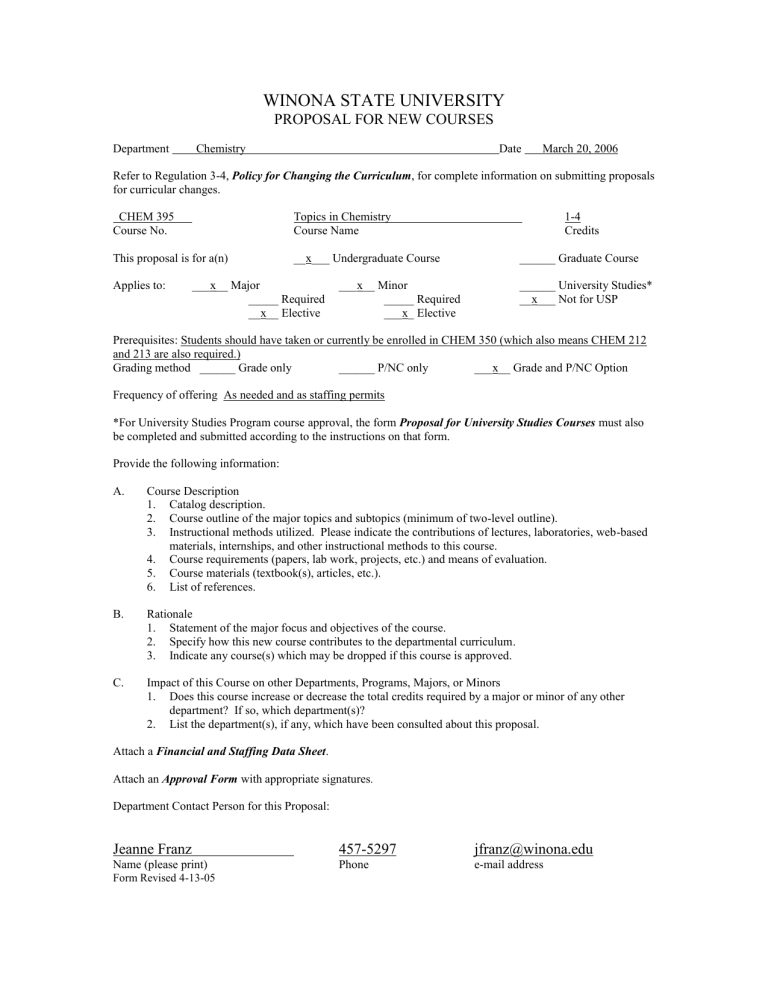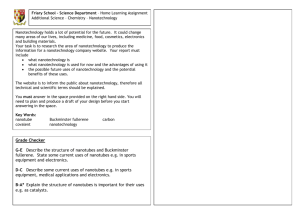CHEM 395 - Winona State University

WINONA STATE UNIVERSITY
Jeanne Franz
Name (please print)
Form Revised 4-13-05
PROPOSAL FOR NEW COURSES
Department Chemistry Date March 20, 2006
Refer to Regulation 3-4, Policy for Changing the Curriculum , for complete information on submitting proposals for curricular changes.
CHEM 395
Course No.
Topics in Chemistry
Course Name
This proposal is for a(n)
Applies to: ___x__ Major
__x___ Undergraduate Course
_____ Required
__x__ Elective
___x__ Minor
_____ Required
___x_ Elective
1-4
Credits
______ Graduate Course
______ University Studies*
__x___ Not for USP
Prerequisites: Students should have taken or currently be enrolled in CHEM 350 (which also means CHEM 212 and 213 are also required.)
Grading method ______ Grade only ______ P/NC only ___x__ Grade and P/NC Option
Frequency of offering As needed and as staffing permits
*For University Studies Program course approval, the form Proposal for University Studies Courses must also be completed and submitted according to the instructions on that form.
Provide the following information:
A. Course Description
1.
Catalog description.
2.
Course outline of the major topics and subtopics (minimum of two-level outline).
3.
Instructional methods utilized. Please indicate the contributions of lectures, laboratories, web-based materials, internships, and other instructional methods to this course.
4.
Course requirements (papers, lab work, projects, etc.) and means of evaluation.
5.
Course materials (textbook(s), articles, etc.).
6.
List of references.
B. Rationale
1.
Statement of the major focus and objectives of the course.
2.
Specify how this new course contributes to the departmental curriculum.
3.
Indicate any course(s) which may be dropped if this course is approved.
C. Impact of this Course on other Departments, Programs, Majors, or Minors
1.
Does this course increase or decrease the total credits required by a major or minor of any other department? If so, which department(s)?
2.
List the department(s), if any, which have been consulted about this proposal.
Attach a Financial and Staffing Data Sheet .
Attach an Approval Form with appropriate signatures .
Department Contact Person for this Proposal:
457-5297
Phone jfranz@winona.edu e-mail address
A. 1. Course Description
Topics in Chemistry-CHEM 395 1-4 S.H.
In-depth study of an emerging field or relevant issue of special interest to faculty or advanced students of chemistry. Lecture only, or lecture and laboratory. Topic announced in advance. Prerequisites: CHEM 350 or current enrollment in CHEM 350. Offered as needed and staffing permits.
2. Course Outline:
Exact topic choice will dictate the outline of the course. The following outline serves as an example of what topics might be covered in a one semester hour course in nanotechnology which is team taught by faculty members from Chemistry, Physics,
Engineering, and Biology.
I. Introduction to Quantum Mechanics:
A. Quantum mechanics applied to nanoscale
B. One-dimensional models of quantum mechanics
C. Collection of atoms
D. Covalent bonds
E. Applications
1. Quantum dots
2. Tunneling electron microscope
3. Atomic force probe microscopy
II. Introduction to Molecular/Chemical Structure
A. Review of basic bonding/intermolecular forces
B. Structural organization
1. Conformations
2. Macromolecular structure
3. Macromolecular architecture
III. Methods of Making Nanostructures
A. Tools for making nanostructures
IV. Structure and Properties of Materials at the Nanoscale Level
A. Overview of various scales and dimensions in which materials exist and focus on the nanostructure of molecules and nano-crystals
B. Properties of materials at the nanoscale level including carbon nanotubes and nanoclay particles
V. Carbon Nanotubes and Nanocomposites
A. Overview of the atomic structure and morphology of carbon nanotubes
B. Carbon nanotube’s mechanical, thermal, and electrical properties
C. Applications of single and multi-wall carbon nanotubes in various composite
materials
VI. Processing of nano-materials and nano-composites
A. Wet-processing
B. Melt processing
C. Applications
D. Challenges of using carbon nanotubes as reinforcement or fillers
VII. Nanostructures in Biology: Transport Containers and Enzyme Arrays
A. Cellular membranes:
1. Structure
2. Function
3. Synthesis
4. Degradation
5. Uses in emerging nanotechnology
B. Microtubules and microfilaments of cytoskeleton
1. Structure
2. Function
3. Synthesis
4. Degradation
5. Possible uses in nanotechnology
C. Motor proteins
1. Structure
2. Function
3. Possible uses in nanotechnology
D. Viruses
1. Life cycles and adaptation of viruses
2. Use as vectors for nucleic acid therapeutics
E. Coated pits & transport vesicles
1. Structure
2. Function
3. Possible uses in nanotechnology
VIII. Environmental Implications of Nanoscience and Technology:
A. History and overview of past environmental mistakes
B. Lifecycle assessment of nanotechnology
C. Toxicological studies assessing nanotechnology
3. Instructional methods utilized:
The instructor and exact topics studied will dictate the exact methods used these may include a combination of lectures, student-led seminar presentations, poster sessions, and laboratory sessions. For the nanoscience offering of this course, the instructional methods utilized will be a combination of lectures and a end-of-the-semester poster session.
4. Course requirements (papers, lab work, projects, etc.) and means of evaluation
: The means of evaluation will differ depending on the number of credits offered. For a one semester hour course on the topic of nanotechnology, students are required to attend every session, ask 2-3 questions of the presenter, (the quality of the question will be graded), and research a topic of their choosing in the field of nanotechnology. A student taking credit in the Chemistry area is required to research the topic in nanochemistry specifically. This topic must then be presented in a poster form to other members of the class, faculty, and members of the public. With more than one credit, more work is expected of the students and may include lab reports, homework,
seminar presentations, exams, and a paper.
5. Course materials
: The exact topic covered will, of course, dictate the materials needed. For a one semester course in the subject of nanotechnology, the course materials may include:
Life Cycle Economic and Environmental Implications of Using Nanocomposites in
Automobiles Environmental Science and Technology , 2003, 37, 3458-3466.
Environmental Technologies at the Nanoscale, Environmental Science and
Technology, March 1, 2003 pp.102A-108A
Nanomaterials: Safe or Unsafe? Chemical and Engineering News , April 28, 2003, pp.
30-33.
Advances in the science and technology of carbon nanotubes and their composites: a review , Erik Thostenson, Zhifeng Ren, and Tsu-Wei Chou, in Composites Science and
Technology 61 (2001) 1899-1912
The World of the Cell , by Becker, Kleinsmith & Hardin in Benjamin Cummings 2003.
6. List of References:
Below is an example of the list of references for a 1 semester hour course in nanotechnology
Recycling Size Exclusion Chromatography for the Analysis and Separation of
Nanocrystalline Gold Al-Somali, A. M.; Krueger, K. M.; Falkner, J. C.; Colvin, V. L.;
Anal. Chem. ; 2004;
The Differential Cytotoxicity of Water-Soluble Fullerenes Sayes, C. M.; Fortner, J. D.;
Guo, W.; Lyon, D.; Boyd, A. M.; Ausman, K. D.; Tao, Y. J.; Sitharaman, B.; Wilson, L.
J.; Hughes, J. B.; West, J. L.; Colvin, V. L.; Nano Lett.; (Communication); 2004;
Chromatographic Purification and Properties of Soluble Single-Walled Carbon
Nanotubes Zhao, B. et.al., Journal of the American Chemical Society ; 2001 , 123, 11673-
11677.
Nanotech: It's Not Easy Being Green, Nano Lett .; (Communication); 2004
Researchers and activists go to loggerheads over the science of small, Sarah Graham
Scientific American , July 28, 2003.
Fiber-optic nanosensors for single-cell monitoring.
By: Vo-Dinh, Tuan; Kasili, Paul.
Analytical & Bioanalytical Chemistry
, Jun2005, Vol. 382 Issue 4, p918-925.
Luminescent nanomaterials for biological labelling.
By: Feng FW Wang; Wee WBT Tan;
Yong YZ Zhang; Xianping XF Fan; Minquan MW Wang. Nanotechnology , Jan2006, Vol. 17 Issue 1, p1-13.
Photosynthetic proteins for technological applications .
By: Giardi, Maria Teresa; Pace,
Emanuela. Trends in Biotechnology , May2005, Vol. 23 Issue 5, p257-263.
Nanotechnology and the Double Helix.
(cover story) By: Seeman, Nadrian C.. Scientific
American , Jun2004, Vol. 290 Issue 6, p64-75.
Future nanotechnology developments for automotive applications.
By: Presting, Hartmut;
König, Ulf. Materials Science & Engineering : C, Dec2003, Vol. 23 Issue 6-8, p737.
Nanomaterials .
(cover story) By: Wood, Andrew; Scott, Alex. Chemical Week , 10/16/2002, Vol.
164 Issue 41, p17.
B. Rationale
1.
Statement of the major focus and objectives of the course.
This course is intended to offer faculty a convenient way to bring topics of current interest and breakthrough technologies into the classroom. Chemistry, by its nature, is constantly evolving. Students are eager to learn about new breakthroughs in their field. Some of these topics may become part of the curriculum a few years down the road; others may be interesting and relevant topics but not mandatory for a practicing chemist to fully understand. This course will be a first introduction of these new materials into the curriculum.
2.
Specify how this new course contributes to the departmental curriculum.
This course will provide an initial exposure to current developments in the field of Chemistry. This course will be an elective course for Chemistry majors and minors. It will provide a first opportunity for faculty and students to learn about new innovations in the field of Chemistry.
3.
Indicate any course(s) which may be dropped if this course is approved.
No course will need to be dropped from the current curriculum because this course will be offered on an as needed and as faculty are available basis.
C. Impact of this Course on other Departments, Programs, Majors, or Minors
1.
Does this course increase or decrease the total credits required by a major or minor of any other department? If so, which department(s)? This course does not increase or decrease the total credits required by a major or minor of any other department.
2.
List the department(s), if any, which have been consulted about this proposal.
The nanotechnology offering of this course was done in collaboration with members of the Engineering, Physics, and Biology Departments.





